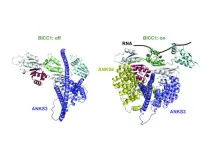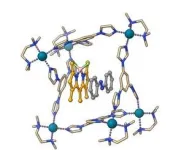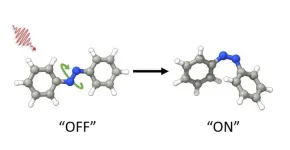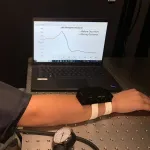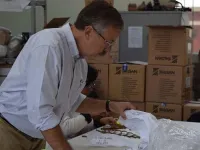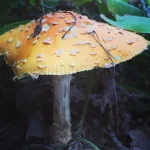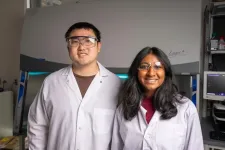(Press-News.org)
In order to keep track of their environment, cells use cilia, antenna-like structures that can sense a variety of stimuli, including the flow of fluids outside the cell. Genetic defects that cause cilia to malfunction and lose their sensory abilities can result in disorders known as “ciliopathies”, including polycystic kidney diseases; but they can also disrupt the correct asymmetric positioning of internal organs during embryonic development – what is known as “organ laterality”.
An example of such asymmetry is the heart, which is typically located on the left side, and positioning its blood vessels correctly in a left-right asymmetrical arrangement is critical for efficient oxygen supply around the body. “Therefore, insights into the molecular mechanisms that mediate the sensory functions of cilia to regulate organ laterality are important,” says Professor Daniel Constam at EPFL’s School of Life Sciences (Swiss Institute for Experimental Cancer Research).
In a new study, researchers led by Constam and Professor Matteo Dal Peraro (EPFL Institute of Bioengineering), have found that the factor which is activated by flow-sensing cilia to specify organ laterality is tightly regulated by two other ciliopathy-associated proteins whose molecular functions have been elusive until now. The study is published in PLoS Biology.
It takes three to tango
We already knew that flow stimulation of cilia determines left-right asymmetry by activating a protein known as Bicaudal-C1 (BICC1). BICC1 binds specific messenger RNAs (mRNAs) inside the cell to accelerate their decay, but specifically on the future left side of the body – like a switch that regulates what, where, and how much of a tissue will be “manufactured” in that particular location. What we didn’t know was how this mRNA-binding activity is itself regulated.
In the new study, the researchers discovered that mRNA binding of BICC1 is jointly regulated by two other proteins, ANKS3 and ANKS6, in an intricate protein network: “We focused on ANKS3 and ANKS6 because both proteins were recently implicated in regulating organ laterality,” says Constam. “ANKS6 is also mutated in a subset of nephronophthisis patients. However, how ANKS3 and ANKS6 function at the molecular level remained to be identified.”
The scientists found that the network of ANKS3 and ANKS6 with BICC1 engages multiple contact sites in an elegant molecular dance: ANKS3 competes with mRNAs for binding BICC1, but is in turn modulated by the protein ANKS6 to control how it interacts with BICC1. These structural changes in the ANKS3-Bicc1 complex, induced by ANKS6, determine whether BICC1 can access specific mRNAs or not.
Fundamental biology and potential treatments for genetic disorders
“Multivalent protein-RNA interaction networks are typically governed by disordered regions in proteins,” says Constam. “By contrast, we found that the BICC1 network is mediated by specific surfaces of well-structured protein domains that either compete or cooperate with one another. The cooperation between ANKS3 and ANKS6 to license BICC1 binding to specific mRNAs represents a new paradigm in the regulation of gene expression.”
Besides contributing to our fundamental understanding of organ development, the study also opens important new research avenues into how this sophisticated switch can be leveraged by cilia and by future therapies of genetic disorders where flow-sensing by cilia is inhibited.
“It’s really the ciliopathies where our findings will matter,” says Daniel Constam. “Inborn organ laterality defects are not something that anybody is even trying to cure in our lifetime, whereas restoring sensory functions of cilia is a top priority for devastating chronic disorders such as polycystic kidney diseases and nephronophthisis.”
Other contributors
RIKEN Center for Biosystems Dynamics
EPFL Institute of Bioengineering
National Center of Neurology and Psychiatry (NCNP), Japan
Reference
Benjamin Rothé, Yayoi Ikawa, Zhidian Zhang, Takanobu A. Katoh, Eriko Kajikawa, Katsura Minegishi, Sai Xiaorei, Simon Fortier, Matteo Dal Peraro, Hiroshi Hamada, Daniel B. Constam. Bicc1 ribonucleoprotein complexes specifying organ laterality are licensed by ANKS6-induced structural remodeling of associated ANKS3. PLoS Biology 21 September 2023. DOI: xxxxxxxx
END
New discovery allows scientists to change the shape of azobenzene molecules using visible light, which is more practical and safe than previously used ultraviolet light. Azobenzenes are incredibly versatile and have many potential uses, such as in making tiny machines and improving technology as well as making light controllable drugs. This molecule can switch between two different forms by light. However, the two forms are in equilibrium, which means that a mixture present that prevents optimal use for applications. Being able to control them with visible light and enrich only one form opens up new possibilities for these applications, making them more efficient ...
In a new study in mice, a team of researchers from UCLA, the Swiss Federal Institute of Technology, and Harvard University have uncovered a crucial component for restoring functional activity after spinal cord injury. The neuroscientists have shown that re-growing specific neurons back to their natural target regions led to recovery, while random regrowth was not effective.
In a 2018 study published in Nature, the team identified a treatment approach that triggers axons — the tiny fibers that link nerve cells and enable them to communicate — to regrow after spinal cord injury ...
Imagine if humans could ‘talk’ to plants and warn them of approaching pest attacks or extreme weather.
A team of plant scientists at the Sainsbury Laboratory Cambridge University (SLCU) would like to turn this science fiction into reality using light-based messaging to ‘talk’ to plants.
Early lab experiments with tobacco (Nicotiana benthamiana) have demonstrated that they can activate the plant's natural defence mechanism (immune response) using light as a stimulus (messenger).
Light serves as a universal means of daily human communication, for example the signalling at traffic lights, pedestrian ...
Three independent state-of-the-art datasets reveal that the West Side has more nitrogen dioxide (NO2) pollution than the rest of the city
Depending on the month, residents in this area experience 16 to 32% higher NO2 concentrations on average
By identifying hotspots, residents and policymakers can be confident about where to prioritize immediate interventions
EVANSTON, Ill. — The western edge of Chicago — including the North and South Lawndale, East Garfield Park, Archer Heights and Brighton Park neighborhoods — experiences up to 32% higher concentrations of nitrogen dioxide (NO2) air pollution compared to the rest of the city, ...
ROCKVILLE, MD – The Biophysical Society is proud to announce its 2024 Society Fellows. This award honors the Society’s distinguished members who have demonstrated excellence in science and contributed to the expansion of the field of biophysics. The Fellows will be honored at the Biophysical Society’s 68th Annual Meeting, being held in Philadelphia, Pennsylvania from February 10-14, 2024. The 2024 Fellows are:
Rommie E. Amaro, University of California, San Diego, USA, is named a Biophysical Society Fellow for her work on developing methods to enable the simulation of biological molecules in situ and ...
WASHINGTON — Researchers have developed a wearable optical device for early detection of hemorrhage during labor or after childbirth. This serious heavy bleeding can be hard to detect before it becomes an emergency and accounts for almost 30% of maternal deaths globally and just over 10% of maternal deaths in the United States.
Studies have shown that early diagnosis and treatment for postpartum hemorrhage is the best way to prevent deaths. The new device is designed to be worn on the wrist, where it uses laser speckle imaging to continuously ...
PORTLAND, Oregon -- The United States’ most distinguished biomedical research award is being given to Oregon Health & Science University physician-scientist David Huang, M.D., Ph.D., for co-inventing an imaging technology that routinely helps prevent blindness and is increasingly used to diagnose and treat conditions of the heart, brain, skin and more.
Huang is receiving the 2023 Lasker-DeBakey Clinical Medical Research Award as a co-inventor of optical coherence tomography, or OCT, the Albert and ...
Violence was a consistent part of life among ancient communities of hunter-gatherers, according to a new study co-authored by a Tulane University researcher that looked for signs of trauma on 10,000-year-old skeletal remains from burial sites in northern Chile.
The study was published in the journal PLOS ONE.
Archaeological research has shown that interpersonal violence and warfare played an important role in the lives of hunter-gatherer groups over time. Still, many questions remain about the factors that influence such violence. The record of human populations in northern Chile extends across 10,000 years, providing a valuable opportunity to study patterns in violence over time.
John ...
Children are taught to leave wild mushrooms alone because of their potential to be poisonous. But trees on the other hand depend on fungi for their well-being. Look no further than ectomycorrhizal fungi, which are organisms that colonize the roots of many tree species where the boreal ecosystem (zone encompassing Earth’s northernmost forests) and the temperate ecosystem (zone between the tropical and boreal regions) meet. This area features a mix of boreal trees including needle-leaved evergreens and temperate tree species including maple and oak.
Just like a healthy human relationship, trees and fungi work well together because they help one another. When the ectomycorrhizal ...
HOUSTON – (Sept. 21, 2023) – To make a gene-editing tool more precise and easier to control, Rice University engineers split it into two pieces that only come back together when a third small molecule is added.
Researchers in the lab of chemical and biomolecular engineer Xue Sherry Gao created a CRISPR-based gene editor designed to target adenine ⎯ one of the four main DNA building blocks ⎯ that remains inactive when disassembled but kicks into gear once the binding molecule is added.
Compared to the intact original, the split editor is more precise and stays active for a narrower window of time, ...
